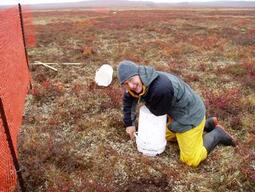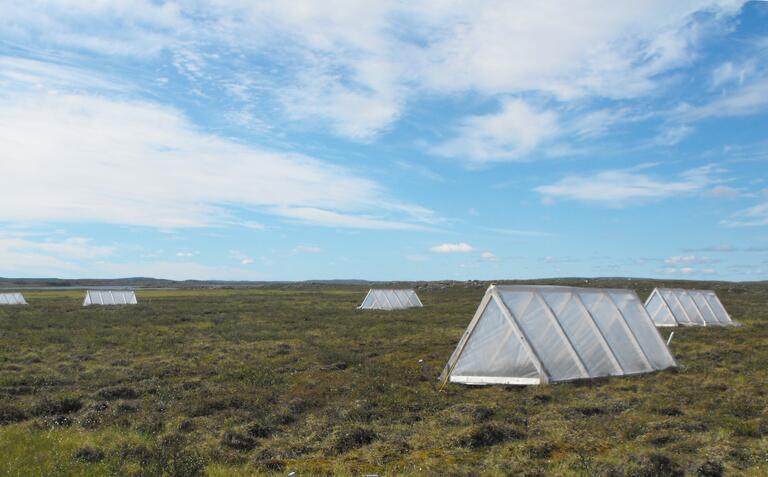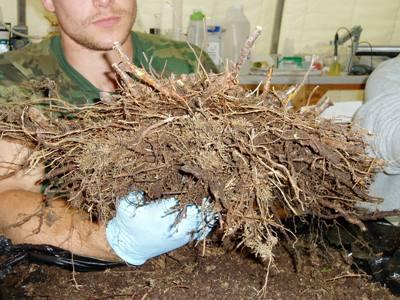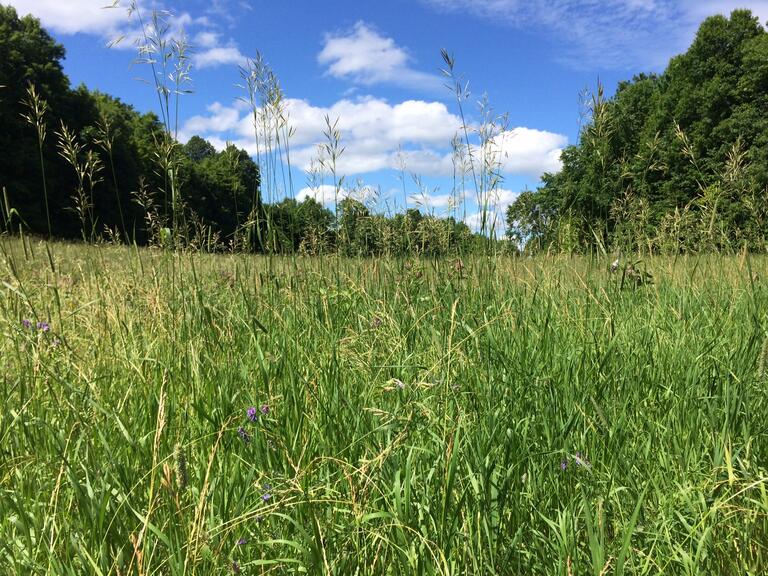I am particularly interested in understanding the inter-relationships between biology and the flows of energy and nutrients in terrestrial habitats because they provide a central foundation on which to explore many fundamental questions in ecosystem ecology. Accordingly, the research in my lab is quite broad in scope but tends to centre on evaluating the physical, chemical and biological controls that govern plant-soil interactions and therefore that significantly influence terrestrial ecosystem biogeochemistry.
We take an hypothesis-driven approach to understanding why ecosystems are structured the way they are, and how they function. As a result, we often find ourselves using experimental manipulations to perturb ecosystems so as to evaluate the relative influences of various controls, or using chronosequences (space-for-time substitutions) to characterise biogeochemical and ecological patterns over time. We currently have ongoing research projects in various tundra locations across the low Arctic, as well several different experiments in local Ontario mature forests and abandoned farmlands, and I have previously conducted terrestrial ecosystem research in mediterranean pine forests and annual grasslands of California, as well as tropical hillslope agro-ecosystems in India.
In essence, we study the controls over biogeochemical processes so as to contribute to better assessments of the impacts of perturbations on ecosystem structure and functioning. Controls include components that are physical (e.g. temperature, moisture), chemical (e.g. substrate composition) and biological (e.g. functional group and species effects of plants and soil organisms). Perturbations include changing climate, shifting land management practices, and increasing atmospheric nitrogen deposition. The underlying rationale is that an improved understanding of biogeochemical processes is essential to predicting the impacts of perturbations on ecosystem structure and function, and therefore to developing appropriate adaptation, management and mitigation strategies.
Lately, I have become particularly interested in directing that component of our research related to climate change in the Canadian North toward addressing the needs and concerns of indigenous peoples in the region. There is clearly an urgent need for Northern science that has indigenous values, knowledge and concerns right at the core. I think the challenge over the next decade will be to develop the infrastructure to promote genuine two-way information exchange between a cohort of multidisciplinary scientists and the indigenous communities of the North, and I look forward to being a part of it.




Some of our past and ongoing projects:
(for up-to-date details, see current research themes and questions)
1. Controls on carbon and nutrient dynamics in low arctic tundra ecosystems.
We have developed a major experimental research site to investigate the potential ecological and biogeochemical impacts of changes in climate and caribou browsing on the structure and functioning of low arctic tundra ecosystems. This research is located at the Daring Lake Research Station in the Northwest Territories, ~300 km north of Yellowknife within the 'Barrenlands' of northcentral Canada. Experimental manipulations of factorial warming and drying, factorial nitrogen and phosphorus additions, low level nitrogen additions, snowfences, and caribou exclosures were started in collaboration with colleagues (Dr. Peter Lafleur - Trent University, and Dr. Greg Henry - University of British Columbia) in 2004 (Daring Lake Research.), and have been maintained ever since.
Our aim is to use the ecological and biogeochemical responses to these manipulations in an integrated way, and in collaboration with colleagues working at other scales (e.g. plant phenology, eddy correlation), to characterise annual patterns of carbon and nutrient cycling and likely impacts of perturbations such as climate warming. In some years we have had the opportunity to hire local northern assistants to help us with our field work (e.g. Tłı̨chǫ Summer Student Research Assistant Program).





A map of the layout of the principal ongoing experimental manipulations across the Daring Lake region, most of which have been established in 2004
2. Shrub-snow interactions and the influence of winter processes on the expansion of shrub cover in the Arctic, and the consequences of such vegetation change for biogeochemical cycling of C and N.
Ecosystems develop and change through a complex set of interactions between biotic constituents and physical factors. Shifts in vegetation architecture constitute one of the most important state changes that can take place in an ecosystem, because these can radically alter the exchange of energy, water, and elements between the geosphere, biosphere, and atmosphere. In the Arctic, a widespread shift from tundra to shrub-dominated vegetation appears to be underway. This land-surface transition could have profound implications for regional climate, carbon balance, and biogeochemical cycling of nutrients.




As part of an international collaboration between our research group at Queen's, and others (Dr. Syndonia Bret-Harte at University of Alaska Fairbanks and Dr. Michelle Mack at University of Florida), we are investigating snow-shrub interactions in Alaskan and Canadian tundra sites, and the effects of natural shrub expansion on biogeochemical cycling of C and N along chronosequences of shrub expansion
3. Arctic Development and Adaptation to Permafrost in Transition (ADAPT).
As part of an NSERC Frontiers program initiative we want to understand and predict the thresholds, non-linear feedbacks and consequences of the northern Earth system as it moves to a higher energy state, with liquid water flow through a much deeper active layer, faster kinetics of all geo-ecosystem processes, and more dynamic interactions, both locally and with the global environment. The overarching core hypothesis is that liquid water and the transformation from solid ice plays a dominant role in driving heat, sediment, carbon and microbial transport in permafrost systems. This research program comprises research projects across northern Canada (see map below) on complementary aspects of permafrost-based landscapes and ecosystems (geo-ecosystems) related to the central hypothesis. ADAPT is organized as four interlocking research modules to address a broad, representative spectrum of natural science and engineering issues within the Integrated Permafrost Systems framework (further details at ADAPT). Dr. V. Walker (Queen's) is colloborating with us in this project.

Map of the principal research sites within the ADAPT project
4. Structural and functional heterogeneity in tundra soil microbial communities across the Arctic.
We’re interested in variation in the community composition of the soil fungal, archaeal and bacterial communities that occur across the Arctic (using PCR-based molecular techniques for Denaturing Gradient Gel Electrophoresis and pyrosequencing). We are analysing variation in ridgetop heath tundra soil microbial communities at scales from meters to 1000 kms using our own samples and those collected by colleagues across the Arctic. At smaller scales, we are characterising differences in soil microbial communities among vegetation-types and investigating their responses to experimental manipulations including warming and increased nutrient availability.


5. Annual and decadal controls on nitrogen cycling in the understory of a sub-arctic birch forest in northern Sweden.
We’ve been studying plant-soil microbial competition for nitrogen using an isotope addition experiment in the understory of a birch forest at Abisko in northern Sweden. The first year's results indicated rapid soil microbial uptake of added N isotope and strong seasonal influences on its release from those microbes into the soil solution. Although vascular plant species appeared to compete strongly for this nitrogen, neither their presence nor total nitrogen uptake appreciably affected microbial nitrogen cycling activity.Together, these results suggest that season exerts primary control on annual nitrogen cycling in this ecosystem, and that its effect on microbial nitrogen turnover is a major process supplying nitrogen to plants (See Grogan and Jonasson, 2003, Ecology in the publications page for details). Recently, as part of a collaboration with Dr. A. Michelsen (University of Copenhagen, Denmark), we sampled the experimental plots 10 years after the isotope addition to determine the longer term pattern of plant-soil microbial competition for the isotope, and to compare nitrogen uptake among the various deciduous, evergreen and graminoid species in the understory plant community.



6. The impacts of increases in deer browsing on plant community structure and soil processes in S.E. Ontario.
Deer populations in S.E. Ontario have increased substantially over the past 50 years due to extensive shrubland development on abandoned farmland, as well as reduced hunting intensity and the absence of wolves. Heavy browsing has lead to serious concerns about forest regeneration and the persistence of some understory plant species. Replicate large exclosures (3 m high X 10 m X 10 m) were established in 2007 in collaboration with Dr. Aarssen (Queen's) to investigate the influence of deer browsing on plant community structure, tree seedling regeneration, soil communities and biogeochemical processes in a deciduous forest site near the Queen's University Biological Station



7. Bottom-up and top-down controls on plant community composition and productivity in temperate grasslands.
What is the primary control on plant community composition and productivity in this region? Ecologists and farmers know that productivity in temperate ecosystems is enhanced by nutrient additions. However, the warm dry summer climate in regions like Ontario suggests that moisture availability may also be a critical constraint on growth and community composition. Furthermore, the relative importance of water may change as precipitation patterns are affected by climate warming in this region.In addition to these bottom-up controls on resource availability, grasslands are also subject to top-down herbivore impacts, and deer populations in particular have increased over the past 50 years. As part of a collaboration with Dr. Aarssen (Queen's), we are investigating the relative influences of water and nutrient availability belowground, and herbivory aboveground, in determining the structure and functioning of local grasslands. Plant community composition and productivity as well as soil biogeochemical properties are being studied in a large field experiment (240 plots) where manipulations of water availability (rainout shelter and water addition plots), nutrient availability (NPK additions) and deer herbivory (exclosures) were begun in a meadow grassland near the Queen's University Biological Station in late Spring of 2011.





8. Carbon and nitrogen dynamics following agricultural abandonment of lands in Eastern Canada.
Substantial areas of land in E. Canada were cleared for agricultural development over a century and a half ago. Many of these areas are now being abandoned and allowed to revert naturally to mixed conifer-hardwood temperate forest. We have identified a series of paired mature forest and adjacent field sites as well as replicated chronosequence sites ranging over a 100 years since agricultural abandonment in the local area around Kingston. This research aims to explore the dynamics of ecosystem carbon and nutrient cycling and soil microbial communities as the vegetation on these sites develops from grassland through shrubland to mature forest. We are interested in the mechanisms underlying biogeochemical change in the sites as well as in their potential for soil carbon sequestration to mitigate increases in atmospheric CO2 concentration.



9. The impact of low-level nitrogen additions on pasture grassland productivity and soil biogeochemistry in S.E. Ontario.
Many regions are experiencing increasing levels of atmospheric nitrogen deposition due to industrial pollution. We've been adding small amounts of nitrogen (2.5 g N per square meter per year) to replicate plots in a hayfield near the Queen's University Biological Station since December 2005 to investigate plant and soil microbial responses to chronic low level nitrogen additions.

































